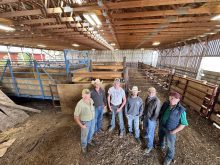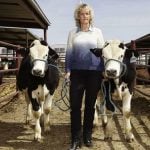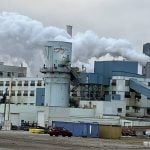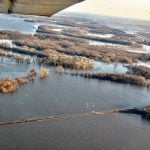When Jerry Baerg first came to the Western Canada Conference on Soil Health and Grazing years ago, he was just starting to think about regenerative agriculture and sustainable practices. Now, he is well-known in the industry for his work in this sphere.
At the Western Canada Conference on Soil Health and Grazing in Edmonton, Alta., in December 2024, Baerg presented on a panel with two other producers, focusing on livestock and soil health. Standing in front of a room filled to bursting, Baerg spoke about the work he is doing on his operation and the effect the conference has had on his management.
“I was just thinking about the first time I came to this conference, and how changing it was for me. There was a lot of new ideas, a lot of processing to do, and it’s really helped shape how I view things,” Baerg says.
Read Also

Building demand together: The impact of Canada’s beef import levy
The beef import levy has become a central tool for ensuring balance in Canada’s beef industry
Cows and grain
Baerg and his wife, Dawn, run Ribbon Creek Ranch near Linden, Alta. The farm has been in Baerg’s family since 1972, under his grandfather. Now, Baerg continues to work on the grain side of the farm with his father and runs a cow-calf operation with his wife.
The cattle side started as a backgrounding operation, but after acquiring more pasture land, they turned it into a cow-calf operation.
Now, he makes sure cattle pass over all their land — whether it is used only for livestock or grain.
“I grew up on a grain farm, but I’m passionate about managing grassland and my cows.”
Baerg has invested time and energy into learning about the environment, sustainable and regenerative practices, and his own operation, taking courses such as Ranching for Profit. In 2022, Ribbon Creek Ranch was named the Alberta Environmental Stewardship Award winner. He is also a director of Foothills and Forage Grazing, and he has used this organization to help with the management of his operation.
Regenerative grazing
Cash crops are still a staple for Baerg — but he is managing them differently now.
“We started putting cows back on the land many years ago and started for economics. It was a cheap way to winter the cows, but by now, I’ve seen the benefits of it.”
The principles of regenerative agriculture and soil health are the same for grain farming as ranching: soil armour, minimizing soil disturbance, plant diversity, continual live plant/root and livestock integration. Baerg adheres to these principles through grazing, no till through a disc drill, rotating cattle for grazing and planting polycultures.
“The benefit of the ranching is using no synthetics. On the annual crops, there is more biomass grown on average … (which allows) more nutrients cycled per acre. Each practice has its place,” Baerg wrote in an email.
One of the pillars of Baerg’s operation is year-round grazing, and he uses his cropland to make this happen. His cattle graze crop residue in the winter, which helps provide a nutrient-dense feed. In the past, he underseeded his cash crops with clover to supply grazing after the cash crops were harvested.
“What are some of the challenges and the benefits of just putting our cattle back onto cropland?” Baerg asks. “Because a lot of us have access to a lot of cropland around us. Some of it’s our own, some of it might be neighbours’, and the benefit of doing that is huge.”
Baerg has converted some cropland into grassland and is including perennials in his rotation because it is hard to find grazing land in his area. He says with markets the way they are right now, he has found it profitable to plant perennials.
“I’ve had friends tell me, ‘You’re going backwards,’ and it’s all right. But I’m really enthused to have perennials in a mix, on a rotation on my farm, just for what it’s doing for me.”
Year-round grazing
Baerg also uses chaff piles in his year-round grazing program. He shares a chaff collector with his neighbour which he uses to collect the chaff into piles for when he opens those fields to his cattle.
Having piles of chaff is also useful in the winter because it makes the feed a little more accessible to the animals.
“Snow doesn’t seem to bother them. They can chug through a lot of snow to get to a pile. They’ll put their heads in and they eat and they clean it up pretty well.”
The calves learn how to dig through the snow for forage from their mothers.
When chaff grazing, Baerg supplements for energy and protein. He says it depends on the crop yield and the weather, alongside other factors.
“You have to learn your cows. You have to learn their needs. And you have to have a really good mineral package, because it is residue, and you have to be really careful with that.”
He also uses swath grazing and bale grazing on his operation. Baerg loves the matter left after his cattle have left a paddock or pasture in the winter because he knows there will be future benefits that come with it.
“To me, that’s beautiful,” he says. “Look at all those nutrients I’ve been able to put on that piece of land that I wouldn’t have been able to otherwise. So that’s just one other aspect of the cattle that are on the land and spreading our nutrients out.”
Baerg has seen benefits from grazing this way. Places where grazing occurs will usually turn green before the rest of the land in the spring.
The nutrients from both the cattle and the leftover feed provide something synthetic fertilizers can’t. On his cropland, his agronomist recognizes that.
“He said we have moved the needle …he said, ‘I’m recommending 30 to 50 per cent less fertilizer needs because of what the animals have done.’ So I was pretty excited.”
Water
With their cattle grazing all year round and moving across all their land, Baerg says one of the biggest challenges is water access. That’s why it is important to have a water plan.
“When we’re grazing in a variety of places, we have to have water, and we have to start planning ahead. You can’t just say, ‘Oh, I want to put cattle out there next week,’ because how am I going to water them?”
What has worked best for him is an above-ground pipe. This has helped him get water to the top of the hills in his area, which prevents the lowlands from being overgrazed.
He also uses portable solar-powered water systems. In the winter, he uses a solar-powered portable water system that activates when the cattle walk up to it as a wet well.
“That is the most trouble-free water I have on my place — works really well.”
Next generation
The regenerative journey isn’t a linear one. Baerg says he is constantly learning and adapting — that’s why events like the Western Canada Conference on Soil Health and Grazing are so beneficial. The conference gives farmers and ranchers a chance to look at what others are doing and learn new practices to implement on their operation.
Baerg is still doing new things. Now, he would like to keep learning and observing his environment and adapt accordingly. He wants to expand his operation and create space for his children to come back to the farm if they want.
“Are we done? No, but we’re on a journey,” Baerg says of regenerative agriculture.
So, he continues to attend the Western Canada Conference on Soil Health and Grazing. “Here we are, how many years later? Still learning, still glad to be here.”
– Melissa Jeffers-Bezan is a field editor for Canadian Cattlemen and a graduate of the University of Regina School of Journalism. She grew up on a commercial cattle farm in western Manitoba, and is now based out of Regina, Sask.

















